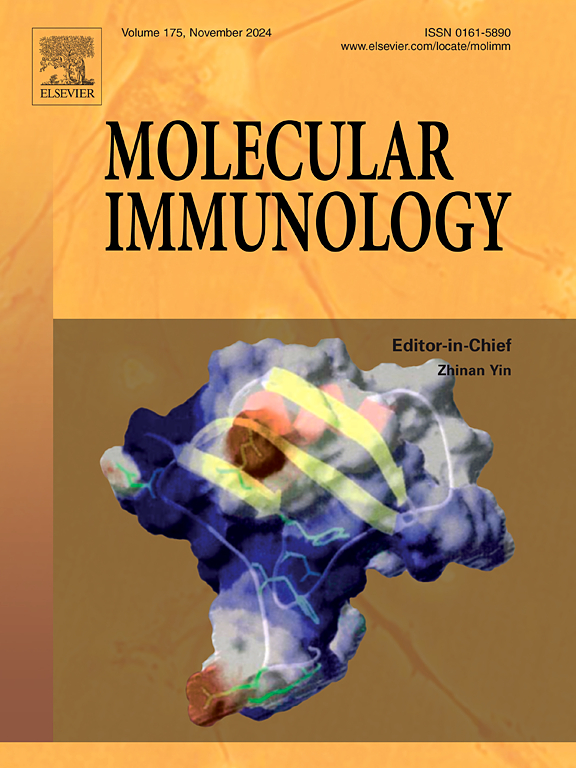Differences in complement activation of serum-resistant and serum-sensitive Klebsiella pneumoniae isolates
IF 3
3区 医学
Q2 BIOCHEMISTRY & MOLECULAR BIOLOGY
引用次数: 0
Abstract
The gram-negative bacteria Klebsiella pneumoniae are genetically heterogeneous and a common cause of sepsis and bacteremia in humans. The complement system is the first line of defence against bacteria when they invade the body. We previously investigated K. pneumoniae isolates from sepsis patients. We found that complement factor (C) 3 is deposited on all isolates independent of serum sensitivity, but the membrane attack complex (MAC) was only formed on the serum-sensitive isolates. To investigate the mechanism for serum resistance, we incubated one serum-sensitive and one serum-resistant isolate in human serum and identified bound complement factors by mass spectrometry. The serum-sensitive isolate had all expected complement factors bound, including C4, while the serum-resistant isolate had only C3 bound. The serum resistance was caused by a fast cleavage of C3b to iC3b. Thereby, the C5 convertase, and thus MAC, cannot be formed. To confirm the role of C4 in serum sensitivity, C4 was inhibited by the nanobody hC4Nb8, resulting in the survival of the serum-sensitive isolate. This suggests that C4 is indispensable for MAC formation through the classical and lectin pathways. In contrast, when activated selectively, the alternative pathway primarily leads to the generation of iC3b, thereby enabling serum resistance by bypassing MAC assembly.
血清耐药和血清敏感肺炎克雷伯菌分离株补体激活的差异
革兰氏阴性菌肺炎克雷伯菌具有遗传异质性,是人类败血症和菌血症的常见病因。当细菌入侵人体时,补体系统是抵御细菌的第一道防线。我们之前研究了脓毒症患者的肺炎克雷伯菌分离株。我们发现补体因子(C) 3沉积在所有分离株上,与血清敏感性无关,但膜攻击复合物(MAC)仅在血清敏感性分离株上形成。为了探讨血清耐药机制,我们在人血清中培养了一株血清敏感和一株血清耐药的分离株,并用质谱法鉴定了结合补体因子。血清敏感的分离株具有所有预期的补体因子结合,包括C4,而血清耐药的分离株只有C3结合。血清抗性是由C3b快速裂解为iC3b引起的。因此,C5转换酶和MAC不能形成。为了证实C4在血清敏感性中的作用,C4被纳米体hC4Nb8抑制,导致血清敏感分离物存活。这表明C4对于通过经典途径和凝集素途径形成MAC是必不可少的。相反,当选择性激活时,替代途径主要导致iC3b的产生,从而通过绕过MAC组装实现血清耐药。
本文章由计算机程序翻译,如有差异,请以英文原文为准。
求助全文
约1分钟内获得全文
求助全文
来源期刊

Molecular immunology
医学-免疫学
CiteScore
6.90
自引率
2.80%
发文量
324
审稿时长
50 days
期刊介绍:
Molecular Immunology publishes original articles, reviews and commentaries on all areas of immunology, with a particular focus on description of cellular, biochemical or genetic mechanisms underlying immunological phenomena. Studies on all model organisms, from invertebrates to humans, are suitable. Examples include, but are not restricted to:
Infection, autoimmunity, transplantation, immunodeficiencies, inflammation and tumor immunology
Mechanisms of induction, regulation and termination of innate and adaptive immunity
Intercellular communication, cooperation and regulation
Intracellular mechanisms of immunity (endocytosis, protein trafficking, pathogen recognition, antigen presentation, etc)
Mechanisms of action of the cells and molecules of the immune system
Structural analysis
Development of the immune system
Comparative immunology and evolution of the immune system
"Omics" studies and bioinformatics
Vaccines, biotechnology and therapeutic manipulation of the immune system (therapeutic antibodies, cytokines, cellular therapies, etc)
Technical developments.
 求助内容:
求助内容: 应助结果提醒方式:
应助结果提醒方式:


